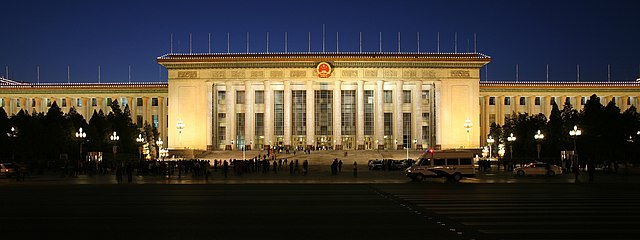A communist state, also known as a Marxist–Leninist state, is a one-party state that is administered and governed by a communist party guided by Marxism–Leninism. Marxism–Leninism was the state ideology of the Soviet Union, the Comintern after Bolshevisation and the communist states within the Comecon, the Eastern Bloc, and the Warsaw Pact. Marxism–Leninism currently still remains the ideology of a few parties around the world. After its peak when many communist states were established, the Revolutions of 1989 brought down most of the communist states, however, it is still the official ideology of the ruling parties of China, Cuba, Laos, Vietnam, and to a lesser extent, North Korea. During most of the 20th century, before the Revolutions of 1989, around one-third of the world's population lived under communist states.
The flags of the Communist Party of Vietnam that were flown besides the Vietnamese national flags in Hanoi, Vietnam
The meeting place of the Chinese National People's Congress
Marxism–Leninism is a communist ideology that became the largest faction of the communist movement in the world in the years following the October Revolution. It was the predominant ideology of most communist governments throughout the 20th century. It was developed in Russia by Joseph Stalin and drew on elements of Bolshevism, orthodox Marxism, and Leninism. It was the state ideology of the Soviet Union, Soviet satellite states in the Eastern Bloc, and various countries in the Non-Aligned Movement and Third World during the Cold War, as well as the Communist International after Bolshevization.
Leon Trotsky exhorting Red Army soldiers in the Polish–Soviet War
Mao Zedong with Anna Louise Strong, the American journalist who reported and explained the Chinese Communist Revolution to the West
Enver Hoxha, who led the Sino-Albanian split in the 1970s and whose anti-revisionist followers led to the development of Hoxhaism
Karl Marx in 1875






